Gizmos can be used to support learning along with a hands-on investigation. Using a Gizmo at different times in the lesson cycle allows students to interact with the content in a variety of ways and modalities. Each Gizmo is accompanied with customizable Lesson Materials and a Teacher Guide that includes strategies and ideas to integrate Gizmos into your lesson plans.
These Gizmos are a few examples of how simulations can support conceptual understanding pre-investigation, as the investigation (supplement or substitution) and post-investigation to enhance learning experiences for students. You can use all of these strategies or pick/choose which best aligns with your teaching style.
Select a Topic for More Information
Integration Ideas
Life Science
Gizmo: Natural Selection
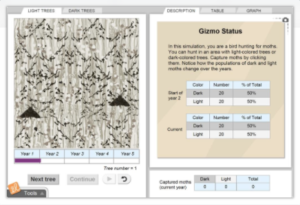
Pre-Investigation Option: Use the Gizmo to run a couple simulations asking students to predict what they think will happen. Switch between light trees and dark trees asking them to explain why they think certain moths are easier to see.
Investigation Supplement or Substitution Option: Assign activity A to half the class and Activity B to the other half and have them run the simulations. Gather data and then have them compare using a jigsaw. Based on what they learned, have them generate a new question and use the Gizmo to investigate.
Post-Investigation Option: Give students the Historical Connection from the Natural Selection Gizmo Teacher Guide. Have them read through the material and then use the Gizmo to provide support or opposition to Kettlewell’s findings
Gizmo: RNA and Protein Synthesis
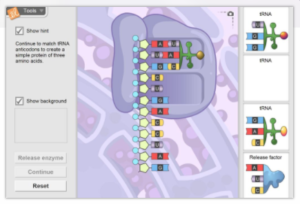
Pre-Investigation Option: Use the Gizmo task card to introduce RNA and protein synthesis.
Investigation Supplement or Substitution Option: Complete activity A as a whole class or skip it if you have already introduced RNA and protein synthesis. Have students work in small groups to complete Activity B and C in the student exploration sheet.
Post-Investigation Option: Use the discussion questions in the RNA and Protein Synthesis Gizmo Teacher Guide and ask the students to support their answers using screenshots from the Gizmo.
Gizmo: Osmosis
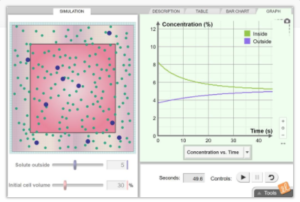
Pre-Investigation Option: Complete Activity A in the Student Exploration Sheet.
Investigation Supplement or Substitution Option: Complete activity A as a whole class. Break your class into small groups and use the format of Activity B, but assign different groups different solute and initial cell volume settings. Have students share their data on the board or a google doc and discuss what happened in each scenario. Assign the Extend your thinking question at the end of Activity B as an individual assessment. You can also use the Osmosis STEM case.
Post-Investigation Option: Take screenshots of the assessment questions at the end of the Gizmo and assign them to students based on their individual needs. Have them answer the questions providing evidence with Gizmo screenshots. You could use a jigsaw to share answers in small groups.
Earth and Space Science
Gizmo: Observing Weather
How can Gizmos support my weather investigation or ‘Home-made Weather Station’ hands-on activity?
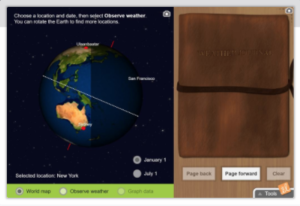
Pre-Investigation Option: Choose the city on the map that is closest or most similar to where you live. Activate prior knowledge by asking students what the weather is like during different times of the year and how they know. Using the Gizmo, go to the city closest to you and observe the weather. Discuss how close the weather in that area is to your area and ask students why it might differ.
Investigation Supplement or Substitution Option: Complete Activity A on the Student Exploration Sheet as a whole class, demonstrating how you would measure and record data. Then in small groups or individually, have students choose two different cities and collect weather data. Choose questions from Activity C to help guide student answers or have them summarize their findings on their own.
Post-Investigation Option: Assign a RAFT (Role – Audience – Format – Topic) paper where students are explorers and they have just discovered a new place. Students will select one city they did not investigate yet and report on the weather conditions using the RAFT format. It is up to you how much you want to assign and how much you want to leave up to the student.
Gizmo: Tides
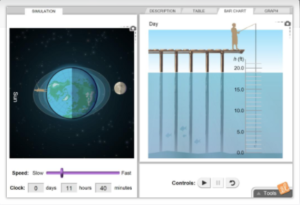
Pre-Investigation Option: Complete the Prior Knowledge Questions and Gizmo Warmup as a whole class. Review the Tides Vocabulary sheet and add/delete any vocabulary words according to your curriculum and lesson objectives. Have the students illustrate each vocabulary word using the Gizmo. Students can manipulate the Gizmo to show the vocabulary word and then take a screenshot and add it to a Google Doc or Word doc.
Investigation Supplement or Substitution Option: Complete Activity A and B in the Student Exploration Sheet, or have the students complete the Tides task card.
Post-Investigation Option: Ask students to plan a weekend of fun on the beach. They will come up with a list of activities on the water and on the beach, but they have to account for tides. Their schedule should reflect tidal changes and they explain why they are choosing that time. They can use the Gizmo to support their schedule.
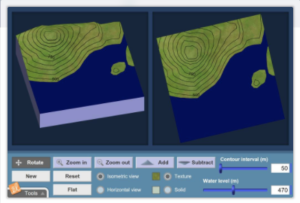
Pre-Investigation Option: Review topographic maps by completing Activity C in Reading a Topographic Map Student Exploration Sheet as a whole class. Give students a premade profile and using the Building Topographic Maps Gizmo, have them create the map. Using the map they made, have students plan out a small community that includes several buildings and other features (swimming pool, tennis court, etc). Students will have to justify the layout of the community based on their topographic map.
Investigation Supplement or Substitution Option: Using the Gizmo Building Topographic Maps, have the students complete the Make a Map and Make a Profile activities. Using the Extension Worksheet, have each student create a new map and paste it on their Extension Worksheet. Then have students trade Extension Worksheets and create a profile for the new map.
Post-Investigation Option: Review topographic maps by completing Activity C in Reading a Topographic Map Student Exploration Sheet as a whole class. Give students a premade profile and using the Building Topographic Maps Gizmo, have them create the map. Using the map they made, have students plan out a small community that includes several buildings and other features (swimming pool, tennis court, etc). Students will have to justify the layout of the community based on their topographic map.
Physical Science - Chemistry
Gizmo: Chemical Changes

Pre-Investigation Option: Use the Gizmo whole group changing the reactants and asking students to identify evidence of a chemical reaction. Discuss equipment, atoms, reactants/products and differentiate between physical and chemical changes.
Investigation Supplement or Substitution Option: Individually or with a partner, ask students to create their own combinations of reactions or provide pre-determined combinations for them to explore. Ask students to collect data in a table or graphic organizer identifying evidence of a reaction.
Post-Investigation Option: Take screenshots of a few of the experiments and ask students to identify physical or chemical changes. Students should write about their evidence and how it supports their observations.
Gizmo: Feel the Heat
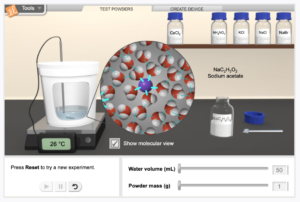
Pre-Investigation Option: Use the Gizmo as an interactive lecture, asking students to make observations about how the molecules bond in endothermic and exothermic reactions. Drag a powder to the bench, adjust amounts of powder/water, then ask students to predict-observe-explain the reaction. Provide choice by asking students to select the next reaction.
Investigation Supplement or Substitution Option: Use the Gizmo as an interactive lecture, asking students to make observations about how the molecules bond in endothermic and exothermic reactions. Drag a powder to the bench, adjust amounts of powder/water, then ask students to predict-observe-explain the reaction. Provide choice by asking students to select the next reaction.
Post-Investigation Option: Use the Gizmo as an interactive lecture, asking students to make observations about how the molecules bond in endothermic and exothermic reactions. Drag a powder to the bench, adjust amounts of powder/water, then ask students to predict-observe-explain the reaction. Provide choice by asking students to select the next reaction.
Gizmo: Titration
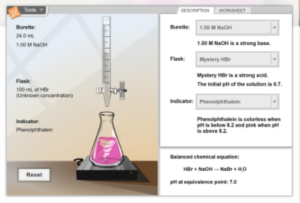
Pre-Investigation Option: Use the pH Analysis Gizmo to discuss how to determine if a solution is an acid/base (Warm-up/Activity A). Use vocabulary in context as you use the Gizmo (terms: acid, base, neutral, indicator, litmus paper) whole group or students working in pairs. Then, use the Titration Gizmo Pre-Gizmo Activity in the Teacher Guide to demo how to change the pH of a solution. Ask students to predict the new pH of the water when adding a strong acid/base and look for patterns in the amount of solution to change the indicator. Model the Gizmo Warm-up whole group to show students how to manipulate the simulation and ask the questions provided. Place students in groups to complete Activity A.
Investigation Supplement or Substitution Option: If equipment or materials are limited, this is a great alternative. Allow students to use titration to determine the concentration of an acid or base (Activity B). Students will then use titration to determine unknown concentrations.
Post-Investigation Option: Activity C, Question 6 allows students to practice titration calculations by selecting Random Flasks. Ask students to solve 3 – 5 analytes, record their data and share their results. Students can create titration graphs and/or complete a Claim-Evidence-Reasoning prompt to answer the question, ie. “How is titration used to determine an unknown concentration?”. Students will determine evidence from class activities and the Gizmo to support their reasoning.
Physical Science - Physics
Gizmo: Feed the Monkey
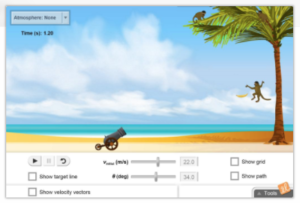
Pre-Investigation Option: Pose a challenge. Allow students to experiment with the Gizmo, trying several different cannon locations, banana velocities, and launch angles to hit the monkey with a banana. Ask students to share their results and identify any patterns from their observations.
Investigation Supplement or Substitution Option: Use the Gizmo to investigate projectile motion, velocity vectors and calculate velocity/acceleration changes. Ask students to create their own version of “Feed the Monkey” using recyclable materials.
Post-Investigation Option: Students complete a Claim-Evidence-Reasoning prompt answering “Where should you aim the cannon to hit the monkey?” Students should provide evidence from Gizmos (including screenshots, calculations, etc…), and any additional resources learned during the unit to support their claim.
Gizmo: Crumple Zone
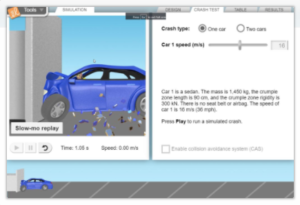
Pre-Investigation Option: Model the Gizmo warm-up whole group to show students how to use the Gizmo and analyze results. Ask students in pairs to design the safest car. Provide the blank data tables for their car experiments. Ask students to identify and explain which parameters are most important to consider when making a car.
Investigation Supplement or Substitution Option: Use Activity D to investigate the work-energy theorem. Allow students to determine the minimum possible force that acts on a passenger by testing the crumple zones of three different vehicles. Use the “Think and Discuss” prompt as a class discussion, writing prompt or assessment question.
Post-Investigation Option: Students complete a Claim-Evidence-Reasoning prompt answering “How do people survive major collisions?” Students should provide evidence from Gizmos (including screenshots, calculations, etc…), and any additional resources learned during the unit to support their claim. This could then lead to students completing an “egg drop challenge” as a final performance assessment to explain the relationship between force, mass, acceleration, and velocity.
Gizmo: Air Track

Pre-Investigation Option: Give students a few minutes to explore the Gizmo and tell you how it works. Ask them to provide any observations about how the gliders move. Split students into groups of 3. Provide them with the scenarios from Activity A, Question 1. Each student selects a scenario to recreate and then share their findings with the group, then the whole class. Ask the students to then create 3 different collisions using any combination of masses and velocities as long as the gliders collide. Record mass, velocity, and momentum before and after the collision by clicking on show numerical data. Explain the principle of conservation of momentum. Ask students to use their data to support this law.
Investigation Supplement or Substitution Option: Create a task card for students to complete in small groups based on Activity C. Student A will use the Gizmo to explore the law of conservation of energy by looking at the velocity before and after the collision and Student B will explore the elasticity of a collision. Students will share their learning with each other. As a class, share findings with the group and close the lesson looking for patterns and establishing a rule to use to explain each concept when provided with data.
Post-Investigation Option: If you have access to an air track, Newton’s cradle, or any other physical model to demonstrate a collision, show a collision and ask students to apply their knowledge from the Gizmo to explain how it works and how it supports the law of conservation of energy and momentum.




